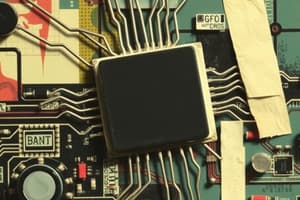Podcast
Questions and Answers
What is a characteristic feature of N-type semiconductors?
What is a characteristic feature of N-type semiconductors?
- They have lower conductivity than P-type semiconductors.
- They have an excess of electrons. (correct)
- They have an excess of holes.
- They are formed from pure silicon.
What happens in forward bias of a PN junction diode?
What happens in forward bias of a PN junction diode?
- Current is blocked.
- The diode behaves like an insulator.
- The potential barrier is decreased. (correct)
- The current flows only in reverse direction.
Which of the following is NOT a property of LASER?
Which of the following is NOT a property of LASER?
- Spontaneous emission (correct)
- Directionality
- Coherence
- Monochromaticity
In the energy band diagram, which statement is true about conductors?
In the energy band diagram, which statement is true about conductors?
What is a key application of LASER technology?
What is a key application of LASER technology?
Flashcards are hidden until you start studying
Study Notes
Energy Band Diagram
- Conductors: Have overlapping energy bands, allowing easy flow of electrons. No energy gap; excellent electrical conductors (e.g., metals).
- Insulators: Possess a large energy gap between the valence band and conduction band, preventing electron flow. Poor conductors of electricity (e.g., rubber, glass).
- Semiconductors: Have a smaller energy gap, allowing some electron transition from the valence band to the conduction band. Conductivity can be manipulated by temperature or doping.
N-type vs P-type Semiconductors
- N-type: Doped with electron-rich elements (e.g., phosphorus) adding extra electrons to the conduction band, which increases conductivity.
- P-type: Doped with electron-deficient elements (e.g., boron) creating "holes" or vacancies in the valence band, effectively allowing positive charge carriers.
Forward Bias and Reverse Bias
- Forward Bias: A condition where the positive terminal of a power source connects to the P-side and the negative terminal to the N-side of a diode, allowing current to flow.
- Reverse Bias: A condition where the positive terminal connects to the N-side and the negative terminal to the P-side, preventing current flow, except for negligible leakage current.
V-I Characteristics of PN Junction Diode
- Current-Voltage (V-I) characteristics showcase a diode's behavior under forward and reverse bias.
- In forward bias, the diode conducts current after reaching a threshold voltage (typically 0.7V for silicon).
- In reverse bias, the current remains minimal until breakdown voltage is reached, at which point the diode may conduct in reverse.
Properties of LASER
- Coherence: Emitted light is monochromatic and in phase.
- Monochromaticity: Produces light of a single wavelength.
- Directionality: Laser light is emitted in a narrow beam with minimal divergence.
- High Intensity: Capable of focusing energy in a small area.
He-Ne Laser
- A common type of gas laser, uses a helium-neon gas mixture.
- Has an energy diagram displaying the excitation of helium atoms, transferring energy to neon atoms to produce laser light.
- Typical wavelength is 632.8 nm (red light).
Applications of LASER
- Used in telecommunications for high-speed data transfer.
- Employed in medical fields for procedures like eye surgery.
- Essential in industrial applications such as cutting, welding, and engraving materials.
- Utilized in barcode scanners and optical storage devices (CD/DVD).
Studying That Suits You
Use AI to generate personalized quizzes and flashcards to suit your learning preferences.




